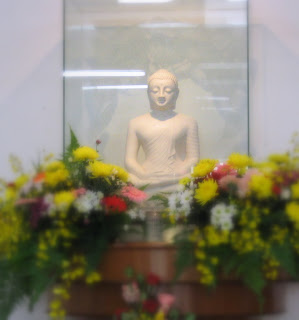 |
| (from http://www.shiftedreality.com/wp-content/uploads/2008/07/darkness_to_light_2560x1600.jpg) |
Tonight talk by Sayadaw U Ukkhamsa at BMBMC is the continuance of yesterday talk about the 7
Bojjhanggas.
In yesterday talk, Sayadaw expounded about
Sati-sambojjhanga. So, tonight the talk is about
dhamma-vicaya-sambojjhanga or Investigative of
DhammaTo know that there is the arises or not arises of this bojjhanga, yogis should know the three aspects of this
bojjhanga namely
- its characteristic
- its function
- its manifestation
What is the characteristic of this
bojjhanga?It is the investigating or the penetrating of
Rupa and
Nama dhammas in their individual essence. Investigation means the discerning and perceiving the true nature of
Rupa and
Nama, its arising and passing away and the association with impermanence, suffering and uncontrollable.
What then is its function?
The function of this
bojjhanga is like a lamp that illuminate as it allows one to clearly see the
rupa and
nama.
What is the manifestation of
dhamma-vicaya-bojjhanga?
This
bojjhanga manifests in yogis as a form of non-bewilderment or clear comprehension. Just like in a dark forest, a person does not know the directions but as soon as there is light he knows the direction. The arising of this
bojjhanga enable yogis to discern clearly the nature of
Rupa and
Nama dhammasTherefore, Sayadaw said, that if a person mention that I feel pain when pain arises he still has wrong you as I feel is a form of clinging. This is
sakkaya ditthi and one can still fall into
ApayaInvestigative of Dhamma will give rise to knowledge. At this point, yogis should know that there are 3 type of knowledge or
nanna.
- Sutta-nana - knowledge gained from learning or listening to Dhamma
- Citta-nana - knowledge gained from thinking
- Bhavana-nana - knowledge from observing or discerning Rupa and Nama right at the present moment
Out of these three
nana, it is the
bhavana-nana will help a yogi abandon
sakkaya ditthi. It is from the arises of this
nana will the
dhammavicaya bojjhanga arises.
What is the cause that this
dhammavicaya bojjhanga that has yet arises will arises?
Sayadaw said it is
Yoniso-
manasikara - observing and noting of all phenomena in all time
.
In the Commentaries, it is stated that there are 7 ways for the arising of
dhammavicaya bojjhanga, namely
- Inquiring and questioning of the Dhamma
- Purification of the bases (internal and external) for example cleanliness of body (internal), clothes or bed (external)
- Balancing of the 5 Faculties namely Faith, Energy, Mindfulness, Concentration and Understanding
- Avoiding ignorance people that are ignorant of Rupa and Nama
- Associate with wise people who are knowledgeable about arising and passing away
- Reflects on profound Dhamma (Teaching of Lord Buddha)
- Inclination toward investigation of gaining knowledge
Sadhu, sadhu, sadhu









































 Today is Wesak Day. Both of us arrived at BMBMC at 9 am, an hour earlier than last year. Not many people yet.
Today is Wesak Day. Both of us arrived at BMBMC at 9 am, an hour earlier than last year. Not many people yet.






